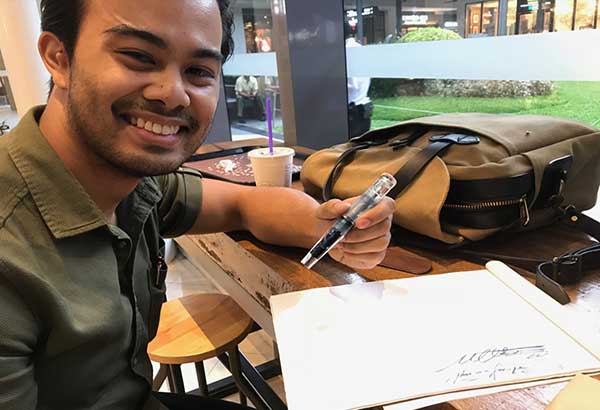The first Filipino pen

Mark del Rosario with his handiwork
It’s been a while since I’ve written about the objects that gave this column its title—my fountain pens — so I’ll indulge myself after many weeks of hardcore arts-and-culture pieces to talk about my favorite pastime. Pens, after all, are both technological and cultural tools without which civilization and knowledge could not have advanced over the past millennium. Just imagine Shakespeare or Einstein without pen and ink, and you’ll see what I mean.
With that excuse out of the way, let me report that for the past year or so, I’ve considered myself semi-retired as far as pen collecting is concerned. Where I used to pick up two to three pens a month, I haven’t (until very recently) bought a pen in half a year; more than that, I’ve sold off much of my collection, bringing down what once would have been around 300 vintage and modern pens to less than half that. I plan to reduce that further to a core of about 50 that I can pass on to my sole heiress, Demi, who will inherit no tracts of land or shares of stock or certificates of deposit, only colorful tubes of plastic and metal with pointed ends and messy blobs.
My most recent acquisitions could hardly even be called spectacular, save one. Off eBay, I picked up two pen-and-pencil sets of Parker Vacumatics from the early 1940s, because they came in the less-common azure pearl color and at a price hard to resist. Last month in California, poking around our usual haunts in the antique malls and flea markets around San Diego, I landed a Montblanc 22 and a Parker 21 from the 1960s, an Esterbrook from around 1940, and a Sheaffer Targa rollerball from the mid-1970s (yes, I keep a few rollerballs around, for filling in those immigration and customs forms on which fountain-pen ink tends to run because of bad paper).

An advertisement from the 1920s with the Rizal pen on the far left
Many people, even those more used to cheap (but perfectly good) ballpoints, have some idea what “Montblanc” is, so let me just demonstrate why it’s important to know what you’re looking for. I saw that near-mint MB displayed in a cabinet in a shop in San Diego, with a tag that said, “Not sure if it works,” which probably explained the very reasonable price of $48. That’s about a third of what this pen — in very good shape and working condition — would go for online. (The 22 is a lower-end but still attractive model and not the fat, cigar-shaped 149 that most people rightfully associate with Montblanc, which sells in the boutiques for about $700 but which you can get, slightly used, for half that price on eBay, if you’re a risk-taker and bottom-feeder like me.)
The seller probably couldn’t make it work because he or she didn’t know how: the 22 is a piston-operated pen, requiring the turning of a knob at its end, and you can see the piston rise and fall in a see-through window on the barrel. That’s how I tested the pen and why I bought it without hesitation (intending to resell it later, but when Beng remarked how nice it was, she instantly became its new owner). In other words — and every collector, every picker of every little thingy from vintage Hamiltons to bird stamps knows this — knowledge pays.
So the MB was a great score, but the piece de resistance of this andropausal batch was truly one of a kind. Filipinos have been among the world’s most avid and most knowledgeable pen users and collectors (we have hundreds of members at fpnp.org), but until recently, no one has ever made one. (We found an advertisement for a “Rizal” pen from the 1920s, but it was likely a British or American pen rebranded for the local market — and yes, I’d happily pay for a specimen!)
That changed when I got a call from one of our members, a bright young man and newly minted MD by the name of Mark del Rosario, who enjoys tinkering with pens, blades, and lathes in his home workshop when he’s not preparing for his internship as a neurologist. Mark had been fascinated by nibs (the pen’s writing point) and had been modifying them to produce different lines, but when he presented me with a box at our meeting and when I opened it, I saw that he had gone much farther than just toying with steel tips — because there was the first fully functional fountain pen ever made by a Filipino, a prototype handcrafted by Mark in frosted acrylic and sporting a lovely smooth German-made Jowo (“yo-vo”) nib. And he was giving it to me for my collection, to honor me as a prime purveyor of our common addiction.
I couldn’t congratulate and thank Mark enough, so I’ll say it here: finding a 1960s Montblanc in California for less than $50 was good, but being gifted with the first Filipino pen by its maker is incalculably better. The only bad thing about it is that now I’m looking at pens again….
* * *
Email me at jose@dalisay.ph and visit my blog at www.penmanila.ph.



















